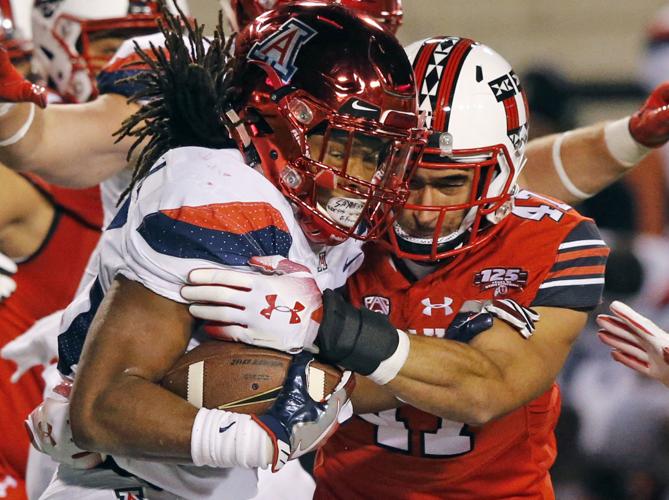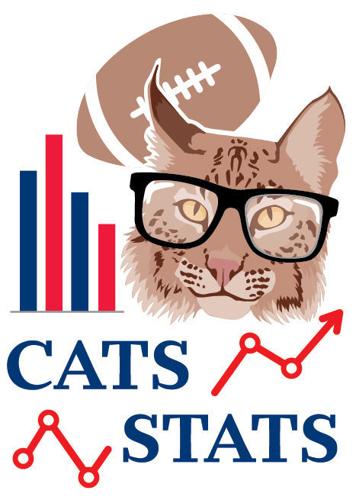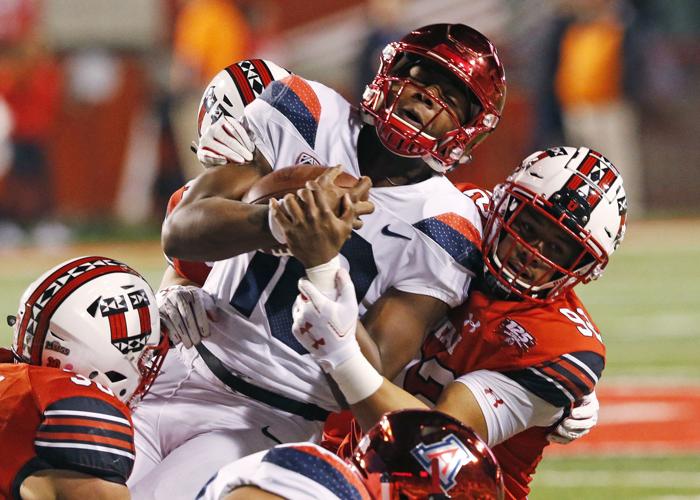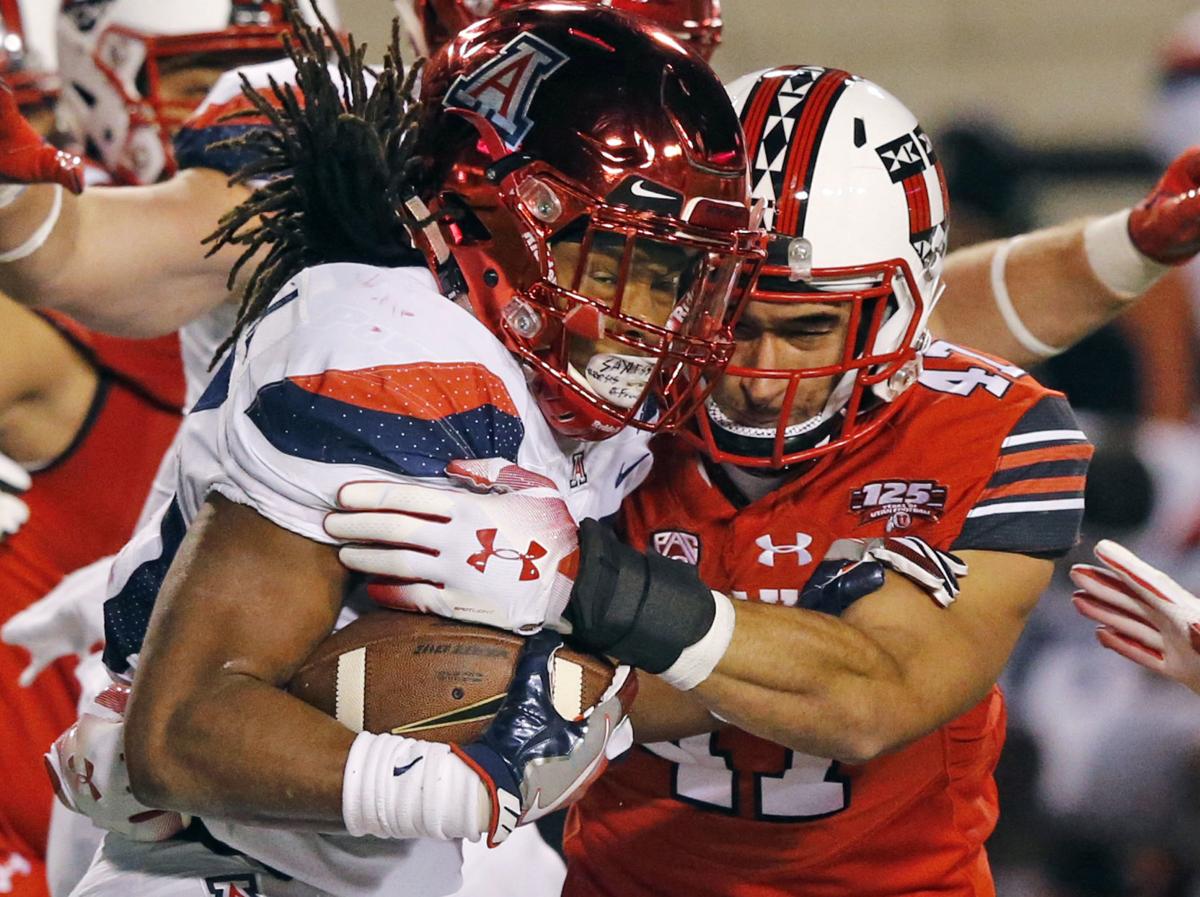Each week throughout the football season, we’ll take an in-depth look at the Arizona Wildcats from a statistical perspective. Here’s the latest edition of “Cats Stats.”
While much attention has been paid to Arizona’s third-down defense — a multiyear problem yet to be solved — the Wildcats’ third-down efficiency on offense has taken a tumble.
Arizona’s third-down conversion rate has nosedived over the past three games, falling from 45.1 percent to 38 percent. What’s behind the slide? How can it be reversed?
We took a deep dive into the UA offense over the first seven games, examining every third-down scenario. What we found is pretty telling. The numbers essentially lay out a blueprint for getting the Wildcats off the field — or at least the previous iteration of them. It remains to be seen how the offense will change with Rhett Rodriguez starting at quarterback against UCLA on Saturday, although his third-down numbers are notable. We’ll get to that later.

Editor’s note
Each week throughout the football season, we’ll take an in-depth look at the Arizona Wildcats from a statistical perspective.
Let’s start with the basics. At 38 percent, Arizona ranks eighth in the Pac-12 and 78th in the nation in third-down conversation rate. Last year, the Wildcats ranked fifth and 44th, respectively, at 42.3 percent.
Arizona was ahead of that pace through four games and had hit Kevin Sumlin’s minimum threshold of 40 percent in each contest. Even in lackluster performances against BYU and Houston, the Wildcats hit the 40 percent mark on the number.
They stepped it up against Southern Utah and Oregon State, games that increasingly look like aberrations. Arizona converted 56.3 percent of its first downs against the Thunderbirds and Beavers. The Wildcats also had only eight third-down attempts in each game. In every other contest, they’ve had at least 15.
If you take out the SUU and OSU games, Arizona’s third-down percentage drops to 34.5. They are the worst teams the Wildcats have faced this season; their combined record is 2-10. Those were also the two games in which senior left tackle Layth Friekh was at his healthiest. Arizona rushed for 268 and 442 yards in those games. The Wildcats haven’t topped 150 in any other week.
Arizona’s inability to run the ball when it wants/needs to has had a devastating effect on the offense.
Through the first four games, the Wildcats had converted 75 percent of the time when needing 3 or fewer yards. Since then, they’re at 27.3 percent. The past two weeks have been problematic to say the least. After going 2 for 3 in third-and-short scenarios against USC, Arizona went 1 for 8 against Cal and Utah.
The Wildcats’ conversion rate on third-and-1 — 41.7 percent — is well below the industry standard. A few years back, SB Nation’s Football Study Hall examined third-down success by distance over a period of five seasons. Teams converted 71.2 percent of the time on third-and-1.
The offensive line has been a sore spot for Arizona since training camp. Projected starting center Nathan Eldridge has been unavailable because of a knee injury. Friekh missed the first two games because of an NCAA ruling and has been hampered by ankle issues the past three weeks. Transfer Robert Congel’s appeal for immediate eligibility was denied. Only one other lineman, Cody Creason, had any starting experience in Division I.
For those pining for Gary Brightwell to become the full-time short-yardage back over J.J. Taylor — a logical move given their disparate dimensions — the numbers so far suggest tailback size isn’t the issue. The bigger Brightwell is averaging 1.7 yards on three third-and-1 or third-and-2 carries; Taylor is averaging 2.8 yards on five such attempts. In goal-to-go situations, Brightwell has 1 yard on two carries; Taylor has 5 yards on four.
Arizona ranked third in the nation in rushing last season behind a veteran line and the explosive running of quarterback Khalil Tate (and, to a lesser extent, Brandon Dawkins). The Wildcats haven’t had either of those elements this season, and it shows.

Arizona quarterback Jamarye Joiner is tackled by Utah defensive end Maxs Tupai. The Wildcats went 1 for 8 in third-and-short scenarios during last week’s road loss to the Utes.
Overall, when needing 1-3 yards on third down, Arizona is converting at a 52.2 percent clip. The Wildcats have converted above the industry standard established by Football Study Hall when needing 4-6 yards; they’re at a healthy 52 percent.
When they need to convert third-and-long — which we’re defining as 7 or more yards — the Wildcats are in trouble.
Arizona has converted just 25 percent of the time when needing 7-plus yards. That figure isn’t that out of the ordinary. The Football Study Hall chart shows a conversion rate of 35.1 percent for third-and-7, and the percentage decreases as the distance to go increases.
That survey doesn’t have raw data for the full five-year period. It does for the 2012 season, and that can help put Arizona’s third-and-long conversion rate in perspective. In 2012, FBS teams converted at a 27.8 percent clip when needing 7-plus yards on third down. It’s hard for everyone.
“You get a lot of different things in long yardage,” Sumlin said. “You think about … a quarterback throwing the ball, but you’ve gotta have protection, you’ve gotta have receivers on the right page, the right depth, running good routes.”
Arizona has had more third-and-long snaps per game (8.7) in the past three games than in the first four (6.5), but again, those numbers are skewed by Southern Utah and Oregon State. The Wildcats have faced 6 to 12 third-and-longs in every other contest. Only once all season have they converted more than 33.3 percent (Cal, 50 percent).
It’s more difficult to convert on third-and-long because you almost always have to pass — and the defense knows it. Tate, who will sit out the UCLA game to rest his injured ankle, has completed 53.4 percent of his passes this season. On third-and-6 or longer, his percentage plummets to 36.1. Last year it was 37.1. (Individual splits are courtesy of ESPN.com.)
Rodriguez, meanwhile, has completed 7 of 9 passes — 77.8 percent — for 99 yards on third-and-6 or longer. It’s a tiny sample size, of course, and he has yet to face a first-team defense that designed its game plan to stop him.
Arizona didn’t suddenly start converting third downs at a crazy rate once Rodriguez entered the Utah game. It was 2 of 6 with Tate and Jamarye Joiner at quarterback, 4 of 12 with Rodriguez. That’s the same percentage: 33.3.
Like the others, Rodriguez needs the support of a productive ground game. If the Wildcats can’t muster one, it won’t matter who’s playing quarterback.







